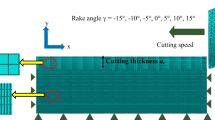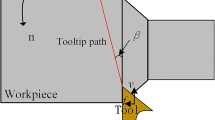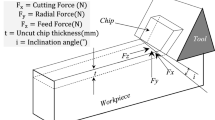Abstract
The finite element modeling and experimental validation of 3D turning of grade two commercially pure titanium are presented. The Third Wave AdvantEdge machining simulation software is applied for the finite element modeling. Machining experiments are conducted. The measured cutting forces and chip thickness are compared to finite element modeling results with good agreement. The effects of cutting speed, a limiting factor for productivity in titanium machining, depth of cut, and tool cutting edge radius on the peak tool temperature are investigated. This study explores the use of 3D finite element modeling to study the chip curl. Reasonable agreement is observed under turning with small depth of cut. The chip segmentation with shear band formation during the Ti machining process is investigated. The spacing between shear bands in the Ti chip is comparable with experimental measurements. Results of this research help to guide the design of new cutting tool materials and coatings and the studies of chip formation to further advance the productivity of titanium machining.
Similar content being viewed by others
References
Hurless BE, Froes FH (2002) Lowering the cost of titanium. The AMPTIAC Quarterly 6(2):3–9
Kraft EH (2003) Summary of emerging titanium cost reduction technologies. Oak Ridge National Laboratory Report ORNL/Sub/4000023694/1, December 2003
Turner PC, Hansen JS (1993) Progress toward low-cost titanium. Adv Mater Process 143(1):42–43
Kraft EH (2002) Opportunities for low cost titanium in reduced fuel consumption, improved emission, and enhanced durability heavy-duty vehicles. Oak Ridge National Laboratory Report ORNL/Sub/4000013062/1, July 2002
Machado AR, Wallbank J (1990) Machining of titanium and its alloys-a review. Proc Inst Mech Eng, Part B: J Eng Manuf 204:53–60
Ezugwu EO, Wang ZM (1997) Titanium alloys and their machinability-a review. J Mater Process Tech 68(1):262–274
Yang X, Liu CR (1999) Machining titanium and its alloys. Mach Sci Tech 3(1):107–139
Rahman M, Wong YS, Zareena AR (2003) Machininability of titanium alloys. JSME Int J, Series C: Mech Sys, Mach Elem Manuf 46(1):107–115
Jones PE, Eylon D (1999) Effects of conventional machining on high cycle fatigue behavior of intermetallic alloy Ti-47Al-2Nb-2Cr (at%). Mat Sci Eng A 263(2):296–304
Yang X, Liu CR, Grandt AF (2002) An experimental study on fatigue life variance, residual stress variance, and their correlation of face-turned and ground Ti 6Al-4V. J Manuf Sci Eng 124:809–818
Komanduri R, Hou Z (2002) On Thermoplastic shear instability in the machining of a titanium alloy (Ti-6Al-4V). Metall Mat Trans 33(9):2995–3010
Sheikh-Ahmad J, Balley JA (1997) Flow instability in the orthogonal machining of CP titanium. J Manuf Sci Eng 119(1):307–312
Molinari A, Musquar C, Sutter G (2002) Adiabatic shear banding in high speed machining of Ti-6Al-4V: experiments and modeling. Int J Plast 18:443–459
Shivpuri R, Hua J, Mittal P, Srivastava AK (2002) Microstructure-mechanics interactions in modeling chip segmentation during titanium machining. CIRP Ann 51(1):71–74
Bäker M (2003) The influence of plastic properties on chip formation. Comp Mat Sci (28):556–562
Hong SY, Ding Y, Jeong W (2001) Friction and cutting forces in cryogenic machining of Ti-6Al-4V. Int J Mach Tools Manuf 41:2271–2285
Gente A, Hoffmeister H-W (2001) Chip formation in machining Ti6Al4V at extremely high cutting speeds. CIRP Ann 50(1):49–52
Norihiko N (2002) High-speed machining of titanium alloy. Chin J Mech Eng 15:109–114
Balkrishna R, Shin YC (2002) A study on the high speed face milling of Ti-6Al-4V alloy. 2002 ASME IMECE, New Orleans, LA, MED 13:277–286
Corduan N, Himbert T, Poulachon G, Dessoly M, Lambertin M, Vigneau J, Payoux B (2003) Wear mechanism of new tool materials for Ti-6Al-4V high performance machining. CIRP Ann 52(1):73–76
Obikawa T, Usui E (1996) Computational machining of titanium alloy - finite element modeling and a few results. J Manuf Sci Eng 118(2):208–215
Ehmann KF, Kapoor SG, Devor RE, Lazoglu I (1997) Machining process modeling: a review. J Manuf Sci Eng 119:655–663
van Luttervelt CA, Childs T, Jawahir IS, Klocke F, Venuvinod PK (1998) Present situation and future trends in modelling of machining operations. Progress report of the CIRP working group ‘modelling of machining operations’. CIRP Ann 48(2):587–626
Stephenson DA, Agapiou JS (1996) Metal cutting theory and practice. Dekker, New York
Marusich TD, Ortiz M (1995) Modeling and simulation of high-speed machining. Int J Num Meth Eng 38(21):3675–3694
Shih AJ (1995) Finite element simulation of orthogonal metal cutting. ASME J Eng Ind 117:84–93
ASM Handbook Committee (1978) Metals Handbook: Vol. 2, Properties and selection–nonferrous alloys and pure metals. American Society for Metals, Metals Park, OH
ASM Handbook Committee (1978) Metals Handbook: Vol. 3, Properties and selection–stainless steels, tool materials, and special-purpose metals. American Society for Metals, Metals Park, OH
Welsh G, Boyer R, Collings EW (eds) (1994) Materials properties handbook: titanium alloys. ASM International, Materials Park, OH
Jawahir IS, van Luttervelt CA (1993) Recent developments in chip control research and applications. CIRP Ann 42(2):659–693
Fang N (2002) Kinematic characterization of chip lateral-curl - the third pattern of chip curl in machining. J Manuf Sci Eng 124:667–675
Cook NH, Jhaveri P, Nayak N (1963) The mechanism of chip curl and its importance in metal cutting. J Eng Ind 85(2):374–380
Nakayama K (1978) Basic rules on the form of chip in metal cutting. CIRP Ann 27(1):17–21
Li Z, Qu G, Xu Y, Rong Y (1997) Formation and breaking of side-curl dominated short-spiral chips. 1997 ASME IMECE, 16–21 Nov 1997, Dallas, TX, MED 6–2:305–312
Boothroyd G, Knight WA (1989) Fundamentals of machining and machine tools. Dekker, New York
Author information
Authors and Affiliations
Corresponding author
Rights and permissions
About this article
Cite this article
Li, R., Shih, A. Finite element modeling of 3D turning of titanium. Int J Adv Manuf Technol 29, 253–261 (2006). https://doi.org/10.1007/s00170-005-2511-6
Received:
Accepted:
Published:
Issue Date:
DOI: https://doi.org/10.1007/s00170-005-2511-6




